Art: From Colours to Counterfeits
From finding forgeries to creating colours, we explore the science of art. Plus, in the news, turning cancer cells into fat, a threat to one of our favourite beverages and is there really a "Dark Side of the Moon"?
In this episode
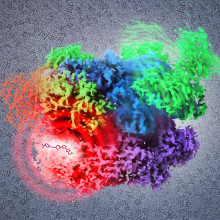
00:50 - Turning cancer cells into fat cells
Turning cancer cells into fat cells
with Gerhard Christofori, University of Basel
A new approach to halting cancer has been announced this week by scientists in Switzerland. They have found a way to make cancer cells convert themselves into harmless fat cells. The technique relies on the fact that the more aggressive tumour cells - which are the ones actually capable of doing the most damage and spreading to other parts of the body - are also the most chemically impressionable; so it's possible to use two existing, licensed drugs to persuade them to transform from relatively unspecialised cancer cells into inert fat cells that can't grow any more. Chris Smith spoke to Gerhard Christofori, from the University of Basel…
Gerhard - So these cells, the aggressive cancer cells differ from the original tumour cells. And being able to survive the bloodstream, to survive in distant organs and also to become resistant to chemotherapy for example but that also makes them also very plastic. These cells have a lot of potential to convert into other cell types and this is essentially what we tried to use.
Chris - So you're talking about persuading these cells because they're highly impressionable and that's why they're so successful on the one hand, but persuade them to become something a lot less nasty.
Gerhard - Yes. And there we started out to essentially culture these cells in dishes and then we used known factors and treatments that we know from, for example, embryonic development that would make up fat cells for example. So the goal was to convert aggressive breast cancer cells into fat cells.
Chris - And why did you pick on fat cells why do you want to make them into fat bearing cells.
Gerhard - Yes there are two advantages of fat cells. The first is that once a fat cell has formed it's not dividing anymore. It's not producing more cells. The other advantage is fat cells are also highly differentiated so they are kind of in the end stage of the function and they are not returning back to the original cell type. So they would not go back to become an aggressive cancer cell anymore.
Chris - So you did these studies, first of all, in a dish. That was the testing that enabled you to find “what signals do I need to expose these cells to push them into that terminal dead end where they become fat cells and there is no going back.”
Gerhard - Exactly, and then by knowing these signals we could deduce which drugs that are available already could be used to replace these signals and these factors and then use these drugs in a mouse model of breast cancer for example.
Chris - And does it work?
Gerhard - And it worked, it worked actually quite surprisingly well. What was also surprising that the mice that were treated did not have severe side effects or actually no obvious side effects, we could not see any toxicities. What we saw is that the primary tumours were not invasive anymore and that these invasive cancer cells converted into fat cells and that the fat cells was essentially just sitting there like normal fat cells in the body. And as a consequence metastasis, so the seeding to distant organs, was also repressed.
Chris - What are the drugs that you use to do this?
Gerhard - So the drugs we used were two drugs. One is called rosiglitazone and it's used in the clinics for the treatment of diabetes and this drug is known to induce the conversion of stem cells into fat cells. The other drug is a cancer therapy called trametinib. It's an inhibitor of a signal that makes tumour cells divide and form more tumour cells.
Chris - And if one compares the outcomes for animals that did have this treatment and animals that didn't. How do the two result sets differ?
Gerhard - There are two major observations. The first one is that the animals that were control treated with the placebo treatment, they showed this highly invasive aggressive primary tumour invasion, and then metastasis mainly in the lungs whereas in the mice that were treated with rosiglitazone in combination with trametinib, we saw a loss of this invasion of malignant cancer cells into the surrounding tissue, also essentially no metastasis in the lungs anymore.
Chris - And if you look at the proportion of animals that responded was it nearly all of them or just a proportion?
Gerhard - It was all of them.
Chris - But the thing about cancer is that it is notoriously heterogeneous. If you look in cancer cells they all have a whole raft of different genetic changes because that's the nature of the beast we're dealing with. So how do you end up with all of the cells responding why don’t we get escape and some cells nonetheless come back and bring the cancer back because it bypasses the blockade that you're applying to it?
Gerhard - This is a very good question. This conversion of tumour cells into this aggressive invasive malignant cancer cells is relatively conserved in different cancer types. It's actually a program that is also used in embryonic development when certain cells have to migrate through the body to form organs. For example, during when the embryo forms and when the organs form. So we anticipate that this program of conversion to malignancy is well conserved in different cancer types and thus most cells will be targeted. And it's possible that even different cancer types can be targeted by the same therapy.

06:28 - Coffee under threat
Coffee under threat
with Alex Summers, Cambridge Botanic Gardens
Coffee is one of the world’s leading love affairs. In the UK we neck down 95 million cups of the stuff every day. But new research suggests that up to 65% of the strains of wild coffee are at risk of extinction. Hannah Laeverenz-Schlogelhofer put the kettle on and sat down for a chat with Alex Summers, glasshouse supervisor at the Cambridge Botanic Gardens, to find out a bit more about the world’s favourite beverage...
Alex - Okay, just a standard instant coffee.
Hannah - Something for the afternoon pick me up.
Alex - Exactly, just to keep the caffeine in the system.
Hannah - With a steaming cup of coffee in hand, we headed to the tropics, well the tropical rainforest in the Glasshouse to see where our caffeine fix comes from.
Alex - The plant from which coffee comes from is a shrub. It's a shrub that can come from the understory of the forest or forest edge and it reaches a reasonable size. We're talking somewhere in the realms of six-eight foot. The leaves are oval, relatively large and they're opposite and the actual coffee that we drink comes from the fruit. So the coffee fruit is a red berry. Imagine something about two or three times larger than the berry you would find on holly. And that's what a coffee fruit looks like. The actual coffee bean is the seed inside that fruit.
Hannah - So when you drink coffee you're actually drinking the ground up seed of a coffee plant?
Alex - Absolutely. So pre-grinding stage those beans will be cured and dried and then they will be roasted and ground, and then you'll get the familiar powder that you will be used to for making coffee.
Hannah - When you see menus at an artisan coffee shop you see lots of different types of coffee. Where do these different types come from?
Alex - Types with coffee, I guess in a lot of cases, is very much like types with wines. So the environment has a huge part to play in the flavour of the coffee beans that you take from the plant, but also the variety of coffee as well. So there are two main species that are used in the production of coffee. There's coffee arabica and coffee canephora which is the robusta coffees. So the top end of coffees that tend to be the Arabica coffees and the real workhorse of coffee so your instant coffee comes from the robusta coffees.
Hannah - A study published in Science Advances reports the results of a global risk assessment for coffee and the results seem quite concerning.
Alex - So the key finding of the paper was that 60 percent of coffee species are at threat of extinction. So what we're talking about is the fact that those two species we were talking about, are two species within about 124 species of coffee. And within those 60 percent of them are threatened with the fact that they may no longer exist within decades to come. And that's major. Well we're actually looking at here is a huge resource if we want greater drought resistance or disease resistance within our coffee crops, then there is potential within the wild relatives of the two coffee species we've just spoken about to actually breed that in to those for future generations, and for future production of new varieties and crops.
Hannah - From increasing numbers of droughts, to faster spreading of disease, coffee species are facing a wide range of threats.
Alex - I think the core risks for the threat to coffee species across their range is habitat degradation and agriculture. And as we see forests cut down for many reasons, we see the loss of habitat for coffee, but also coffee species tend to be range restricted. This means that in many cases they've evolved to quite tight specific climatic conditions and therefore they're not very flexible in moving into new habitats or new ranges when their current habitat is degraded. Disease particularly in areas of domesticated crops where we tend to grow one or only very few varieties become a real problem.
Hannah - With these species at risk, what can we do about it?
Alex - There's two areas that are highlighted here which is improved conservation in situ, so improved protection for areas or regions which have coffee wild relative species, but also from growing them outside of their normal range perspective. So things like we are here at the Botanic Garden, doing that is really important as well. Particularly because coffee have recalcitrant seeds, you can't store the seeds in dry cold storage. And in this case to build a collection of coffee outside of its normal range you have to grow it as a plant. And one thing that we have to recognise is the importance of botanic gardens to contribute to that. And also from botanic gardens perspective we all have to talk to each other more, and make sure that we are not all just conserving a small portion of that diversity, of both robusta and Arabica, but also of the other species.

12:46 - How fever helps you fight infections
How fever helps you fight infections
with Clare Bryant, Cambridge University
The headache and sore throat that accompany a cold or the flu make you feel bad enough, so why does the body make us feel doubly awful by throwing a fever into the mix and cooking us in our own skin? We knew already that some infecting microbes grow less well at higher temperatures, but now scientists in China have discovered that a higher body temperature also helps immune cells get to sites of infection more efficiently. Immunologist Clare Bryant, from Cambridge University, spoke to Chris Smith, after taking a good look at the findings...
Clare - What happens is there are a bunch of proteins produced in response to infections and other immune processes that then drive the production of molecules called prostaglandins and they cause an increase in their body temperature and that's really important for making a hostile environment for bugs. But also it seems that if you get this increase in temperature it increases your chances of surviving and recovering from infection. Very important. And it's very interesting as to why that might occur.
Chris - So basically the body temperature is set your brain isn't it? And there are chemicals released by the response to the infection that then triggers that set point upwards and we all do it. And animals do it as well, everything does. It clearly has a benefit to us.
Clare - Yes absolutely.
Chris - So what actually are the researchers in China saying in their paper? What did they do?
Clare - So what they did was they had a look at an interesting process that goes on which is you need your immune cells to actually get to the site infection site information. And in order to do that the immune cells such as T cells for example actually have to jump off the train of the circulation and get into the site of the tissue that's infected.
Chris - So they're going round in the bloodstream, these white blood cells, and they need to be not in the blood they need to be where the action is, in the actual tissues.
Clare - Yeah so they're patrolling in the blood and they need to get off and into the tissues in order to work that out. So the tissues do some very neat ways of producing chemicals that will attract these cells into the tissues but they actually need to get off, get off the train. And so what happens is that the lining vessels of the blood stream produce a bunch of sticky molecules and then the receptors in things like T-cells see these. And then what they do is they sort of stick and they roll along the blood vessel wall in this kind of sticky way, until they reach a site of infection which is indicated by chemoattractants ,so those are molecules that attract these cells in. And then these cells actually move from the blood vessel wall into the tissue and that process - stick, roll and invade.
Chris - That is how the tissue recruits the cells out of the bloodstream it makes the blood vessels in that region that's got the infection in it more sticky than normal so the cells can gain a toehold and then get in. But how does the temperature side of things come into that because we've been able to watch down microscopes that process you've just defined for many years, we knew that blood cells begin to stick better in areas where there's an infection. So where does the temperature come in?
Clare - This is the really neat thing about this paper so what they did is there is this bunch of proteins which are specifically up regulated when you get a fever, they're called heat shock proteins. And in this paper what the guys did was they showed that one of those and only one of those proteins called HSP 90 heat shock protein ninety was up regulated.
And then what it was able to do was to send a signal from the inside of the cell to the outside of the cell through a very specific protein called alpha-4-integrin which is a protein that actually makes the stickiness, it’s the stickiness receptor.
Chris - Like cell Velcro?
Clare - Exactly like cell Velcro. And so what happens is that the HSP 90 binds to the tail of the alpha-4-integrin and this up regulates on the cell surface. But even neater than that, this protein can combine two molecules of the integrin. So you get clumping of these receptor proteins and makes multiple stickiness and increases the maximum stickiness to the blood vessel wall.
Chris - So in other words you've got the area where there's an infection making the blood vessels there a bit more sticky already. We knew that. But when you add onto that the effect of the raised body temperature that's making the cells that need to go to that site of infection a bit more sticky as well. So the combined effect is going to be it's much easier for the cells to cling onto the side of the blood vessel where there is a zone of infection and then squeeze into the infected areas.
Clare - Exactly right because the alpha-4-integrin is absolutely critical for the stop and invade signal.
Chris - And now we understand a bit more about this process of inflammation, there are lots of diseases where the immune system runs amok, auto immune diseases like SLE and arthritis. Would it be possible to exploit this in order to damp down the immune system because without it we obviously need the immune system to get rid of infection but when we don't want the immune system attacking things you get all kinds of consequences.
Clare - Yeah. The really neat thing is now that we understand the mechanism involved, this up regulation of the heat shock protein 90, you can actually down regulate that, you can switch it off. And in doing that you'll then reduce stickiness and you reduce the level of immune invasion of these tissues so things like rheumatoid arthritis for example the joints will no longer be infiltrated by these T-cells and that should down regulate the immune response.
Chris - They did this in experimental mice. Do we have the same molecules in humans? Can we assume this is applicable to us?
Clare - Yes we do. The heat shock proteins are evolutionary conserved as are the integrins. So it's very likely that we should be able to target immune diseases by using an approach on this sort of molecule.
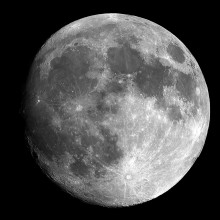
18:07 - Myth: the dark side of the moon?
Myth: the dark side of the moon?
with David Rothery, Open University
When you look up at the Moon, you always see the same thing. To some it’s a face - the Man in the Moon - to others, it’s a giant rabbit or an elegant lady. But seeing the same face lit up has led to discussions on what must be on the other side, which some label as the “Dark Side of the Moon”. The phrase has been frequently repeated recently in the wake of the landing by the Chinese of their Chang’e 4 rover on that side of the Moon, and this has got David Rothery, Professor of Planetary Geosciences at the Open University, almost spinning off his axis, and he’s on a lunar mission to right this scientific wrong...
David - On the 3rd of January the Chinese landed on the dark side of the moon! Well did they?
I mean, I got fed up of hearing about it and reading about it put that way in the press. But the moon doesn't have a dark side, at least not a permanently dark side. I'm a Pink Floyd fan but, sorry, there is no dark side of the moon.
The Chinese landed on the far side of the moon. That's the side of a moon that permanently faces away from the earth. But it's no darker than the near side, it sees just as much sunlight as the near side of the moon does. In fact, a little bit more because on the far side of the moon you never see the Earth getting in the way of the sun.
So let's get rid of this phrase “the dark side of the moon”. Metaphorically it's dark but it's misleading. It is the far side of the moon.
Now, like almost every known moon in the solar system, the moon has this property of rotating once for every orbit it makes round its planet. So one side, the near side, always faces towards the planet. The opposite side, the far side, always faces away from the planet. And, if you're on the surface of the far side of any of these moons, you wouldn't be able to see the planet because it would be below the horizon.
Now why does this happen? Well, it's due to tides. Tidal forces have slowed down each moon's rotation, suddenly it rotates exactly once per orbit. And that then means that you don't have to be distorting the shape of the body by moving tidal bulges around the solid surface of the body because the total bulges can stay fixed in place facing towards underway from the planet.
So that's it. Our moon has a far side but not a dark side. So please if you hear somebody talk about the Chinese or anybody else landing on the dark side of the moon, gently put them right.
But what a great achievement to land there on the far side of the moon. There's no line of sight to the earth. You can't get radio signals to and fro. So the Chinese put the quasar relay satellite in a halo orbit around the Lagrange point on the far side of the moon from the earth so it could always see the far side of the moon and over the horizon to the earth. Brilliant technical job to land on the far side of the moon. And we're going to learn a lot about the far side of the moon when we put rovers down in more interesting places there...
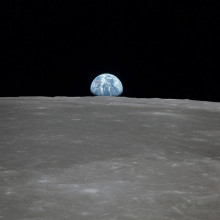
21:30 - The Moon's meteor history
The Moon's meteor history
with Thomas Gurnon, Southampton University
During its 4.6 billion year history, the Earth has been bombarded by comets, asteroids and, on one occasion, even a planet smashed into us. The product of this latter collision was the Moon! And the Moon can reveal a lot more about what’s hit the Earth than the planet itself can, because, unlike Earth, the Moon doesn’t have weather, tectonic plates, or Ice Ages constantly remodelling its landscape. Instead, the lunar surface carries a near-pristine record of the sorts of objects that have been slamming into us over the aeons.Adam Murphy spoke to Thomas Gernon, from Southampton University, who was on the team who has worked out how to interpret the lunar landscape to decode what’s been arriving, and when...
Thomas - Our team used data collected by NASA's lunar reconnaissance orbiter which is the spacecraft which has been orbiting the moon for the past decade or so gathering data. What we found was a strong link between the rock abundance surrounding these big impact craters and their age.
What that means is the younger craters tended to have much larger blocks exposed around them than the older craters which were surrounded by finer material. This correlation was substantiated by craters that we have dated quite well using samples, for example, from the Apollo mission. Using this really strong correlation we were able to actually date over 100 of the moon's largest impact craters and effectively produce the first chronology of these large craters on the moon. So really interestingly both the Earth and the moon reveal a strong increase in the impact flux around 290 million years ago, so just before the age of the dinosaurs. We think that there were two to three times more rocks colliding with the planet, with Earth, just before the dinosaurs had evolved. So it's possible that this spike made the impact thought to have wiped out the dinosaurs on earth more likely.
Adam - How do things weather on the moon. Because there's no atmosphere there, so there's no kind of wind and weather. How did things actually weather down?
Thomas - What we think is the large rocks are effectively breaking down over hundreds of millions of years. And we think that the rocks are breaking down due to two things. First is a bombardment of micrometeorites, these are tiny fragments which are constantly pummeling the moon's surface. And the other reason is that we have thermal cycling. The lunar day is on the order of 28 Earth days and so we switch between 14 days of daylight and heating the rocks up and 14 days of nighttime when the rocks are cooling down.
Adam - And that rapid heating and cooling and the extremes is what breaks them down?
Thomas - Absolutely. So they are, we think, gradually breaking down and I guess over a billion-year timescales your big blocks are going to turn into soil or what they call lunar regolith.
Adam - What implications does your data have for Earth then?
Thomas - We compared the age distribution on the moon with those of the earth. What we discovered was surprising, that the actual impact fluxes were almost identical on the moon and the earth over the past six hundred and fifty million years. This was surprising because we often assume that the earth's impact record is biased due to erosion and so on.
Adam - Was there any period of earth that doesn't have craters that you were able to find did have bombardment?
Thomas - Startlingly what we found was the similarity between the Earth and the moon stopped at 650 million years ago. What we see is an abrupt cutoff on the earth of the impact craters which otherwise we would have expected to be present using the moon as an analogy. This lines up really well with a period in which the earth experienced really severe global glaciation, dubbed “snowball earth”, which is thought to have lasted for tens of millions of years. And in another recent paper, we demonstrated that as compelling evidence that there was really high levels of erosion during this snowball phase. And what we suggest is erosion on the order of three to five vertical kilometers, on average, across the continents. And this is unlike anything ever seen during Earth history. This is effectively a period in which we've we've scraped all of the really big impact craters off the face of the earth surface almost like a Brillo pad.
Adam - What's the next step then what's the next thing to look at?
Thomas - We're excited about pushing the limits of this technique and maybe seeing if it applies further back through history over several billion years of time. What we've done is use the moon as a catalogue in order to effectively understand the Earth process so we can learn a lot about for example erosion and plate tectonics through earth's history by looking at other bodies within our solar system and that's really exciting for me.

The art in science
with Katie Reinhart, Sietske Fransen, Making Visible Project, CRASSH
Scientific Illustrations have always been vital to science’s history: Charles Darwin was a scientific illustrator, and so was author Beatrix Potter. Adam Murphy took a trip to the Whipple Library in Cambridge to speak to Katie Reinhart and Sietske Fransen from the Making Visible project, to learn about this kind of science...
Adam - Today we have photos, films, and even virtual reality to show us our science. But these things weren't always about before then. Scientists had to use incredibly, perfectly detailed drawings of the things they wanted to discuss. I took a trip to the Whipple Library in Cambridge to learn about this from Katie Reinhart and Sietske Fransen. First, Katie told me about the overlap between science and art.
Katie - I can't give you sort of exact numbers but there are instances of both. So some of the fellows like Robert Hooke were themselves made many images. We know that Robert Hooke apprenticed with Peter Lely the painter. So many of the things in the archives he, made himself, many of the drawings, he did. But many fellows didn't. We also know that they worked with craftsmen and artists who made images for them, particularly for their published works because making wood blocks or making engraved images, cutting a copper plate for an engraved image was a specialised skill so there you'd need to go to someone who had the training to do that.
Adam - But how important was art to these scientists? Sietske Fransen told me more.
Sietske - It was part of a gentleman's education to learn to draw and that is not only for science but also to understanding art. So we know from handbooks in the 17th century that people were told to look at engravings of famous portraits or other paintings and copy them to learn to see, and that is of course a very important skill also within science.
Adam - Then we dived into the library archive, starting with a book by Robert Hooke contemporary, and rival of Isaac Newton. And the book of his that I was shown was very, very interesting to this history lover.
Katie - This is a first edition from 1665 of the Micrographia, which was Hooke's book about the things he saw through the microscope.
Adam - And one of the things you see is this. Is this a flea, a giant image of a flea?
Katie - Absolutely. It's exactly as you say it's a giant flea.
Adam - How did this image come about? How did he actually get this?
Sietske - So we know that Robert Hooke was a draughtsman, as we already said so he probably drew the image himself and then had copper plate cutters, or copper plate engravers to make the actual image for the publication. And one really important thing to realise is, looking at this image which is almost two A4 pages in current size, it is a compound image. So if you look through a microscope, through a 17th century microscope you can never see an entire flea like this. So it means you had to look several times, he had to move the flea, and see through the lens and then all these things that he saw then connect into one image.
Adam - Images today are commonplace in science. What was so revolutionary about these ones?
Sietske - I think the revolutionary thing that everyone has seen a flea before because they were really more common than now. So they were jumping on us and on the animals around. But no one had ever seen them so close by. So they didn't realise that there were hairs on the legs, for example.
Adam - Other than drawing pictures of tiny things. Where else was this so important?
Katie - One thing that we've really found in this research we've been doing, is that images were used in every discipline of science. So we see images of astronomical observations, of stars and comets, of things seen through the telescope. We see ones of human anatomy, around dissections, around kidney and bladder stones that were cut out of people, sometimes before, sometimes after they died. We see them in what we would now call physics or chemistry because we see drawings of instruments that were invented or designed, sometimes that actually were created and used, different air pumps and sometimes ones that weren't, kind of, fictional instruments or ones that never came to fruition that they didn't work, or were never created. And on top of that we also see many many mathematical diagrams, kind of, the proofs you made in geometry and algebra when you were in school those type of mathematical proofs and diagrams we see all the time.
Adam - And the time of scientific illustration was an important one for women who were often excluded from other aspects of science.
Sietske - There were women artists working and we have several examples within the royal society again. So for example the two daughters of Martin Lister, helped or made many of the images for his publications. So there are definitely women involved and we know even less about the women than we do know about than the male scientists. But it is possible that some of the artist of whom we don't know the name were actually women.
Katie - Yeah I think that's a good point about both women scientists and women image makers that in this period of time much of that labor is still uncredited.
So we don't know, just as we don't know who did the engravings for many of these images. Those unknown people could be women and women we know, kind of, disproportionately weren't given credit always for the work they did.
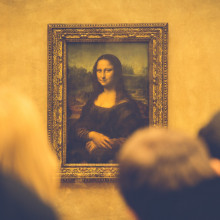
32:58 - Preserving historic paintings
Preserving historic paintings
with Paola Ricciardi, Fitzwilliam Museum
What if you need to protect old, precious artwork. How can you learn more about it, and keep it safe, without damaging it? Chris Smith spoke to Paola Ricciardi, a scientist at the Fitzwilliam Museum in Cambridge who is researching non-invasive ways to study artefacts...
Paola - Well the first thing we do is we take a really good look at it and we use a range of imaging and spectroscopic methods to figure out for example, who painted something, how did they paint it and where did they get the materials that they used? Who commissioned artwork? Why did they commission it, when was it commissioned? What's the context behind artwork? We do a lot of forensic science I guess you could say.
Chris - It’s like a postmortem for a painting.
Paola - Absolutely. That's exactly what we do.
Chris - But someone hands you a picture and you can tell all that just from the picture?
Paola - Well you have to take it to the lab and you have to use quite a different range of light methods. So we use x-rays, use infrared light, UV light, visible light and with that range of different spectroscopic methods you can actually figure out lots of things about, you know, a painting. Just to give an example, if we use infrared light, take an image of the painting, usually you can see what's underneath and what is underneath could be a sketch that artist made before he painted the object. And different artists usually have different drawing styles. And so that's a really good way to distinguish for example between the work of different artists even if it's not immediately apparent from the painting itself.
Chris - Is the key the non-destructive aspect of this that you're using light to interrogate the surface, and the light just bounces pretty much harmlessly off but there's information written into that light that's coming back and that gives you the clues as to what's in there.
Paola - Exactly yes. We exploit different ways that light interacts with matter so it can backscatter you know it can bounce off in different ways as you said. And those different ways means we can detect whatever light comes back to our instruments.
Chris - So that tells you the sort of chemical imprint or fingerprint that's in the pigments that the artist used, so you can get a chemical signature almost.
Paola - Exactly. Yes. So some methods such as Raman spectroscopy, which has nothing to do with noodles but more to do with an Indian scientists, who actually discovered the effect.
Chris - So Indian rather than Chinese or Japanese?
Paola - Yes. Mr. Raman was an Indian scientist who discovered the Raman effect. So what that does is it gives you the molecular fingerprint of your pigment in this case. It identifies exactly what kind of material you're looking at.
Chris - And presumably different people who went to art school at different times in history would have worked with a specific or fairly unique palette, that would have been unique to them as a painter but also the era in which they were working. Is that a reasonable deduction?
Paola - It's a really good point but unfortunately for most of history the palette is pretty much the same.
Chris - So what works works, so go on using it.
Paola - Yes exactly. It's only in the late 18th, early 19th century that we start seeing different pigments coming up and that's actually detecting those pigments in historic old master paintings for example, is a really good way to test if someone’s done something to them.
Chris - Yeah. Do you also get to understand how time affects those pigments, because one of the keys is,you know,if we're looking at a picture it is 500 years old that's had a lot of time on the wall it's had a lot of light and sunlight bleaching, it has had oxidation, people used to smoke a lot these things and Elizabethans were notorious weren’t they. You used to get these enormous pipes and things there would've been clouds of smoke going everywhere. So can you begin to see how those pigments have changed over time, how they've chemically interacted with the environment they've been in and therefore a) how to predict what it would have looked like that picture and b) how to put it right.
Paola - Yes. Yes that's exactly what we do and that's why we work so much in collaboration with conservators, thus to protect and you know stabilise and conserve these objects for the future. So we try and detect various types of degradation for example that you might see on a painting and figure out whether we can stop that. We don't usually want to reverse it or it's not always possible to reverse that. You don't usually want a painting today to look like it hasn't had any history you know it is a 500 old object you're supposed to look 500 years old.
Chris - Someone did say to me that you know part of the art is that it continues to evolve and change.So it would be a bit wrong for us to intervene in that natural aging process which would be robbing something away from the art to wind time back but. But can you do it digitally if you take a picture of that and you understand how the image has been changing over time chemically. Can you ask the computer, well wind the clock back wherever you see these different pigments being used and put them to how they would have been.
Paola - Absolutely in fact a team at the Getty Museum has done exactly that and they did that comparing a painting which had aged and darkened over time, with a manuscript illumination painted by the same artist because the manuscript has been closed in a book for 500 years. And so it hasn't aged, hasn't been exposed to light and smoke and other degrading agents. So they took that color and so digitally manipulated a painting to make it look like that.
Chris - And are you shocked as it look does it look strikingly different?
Paola - It absolutely does, it's very different and it's amazing actually.
Chris - So all there instances where you would want to intervene because I've heard it said by various chemists and things that you do end up with various chemicals that can be destructive to a painting and actually you do need to intervene and stop things. So are there ways to do that? And can you do it in a way that is sympathetic to the art.
Paola - Absolutely. Conservators nowadays would intervene on a painting if someone in the past intervened in a non-sympathetic way. And then you want to remove that previous intervention and make sure that you preserve the paint.
Chris - Well that's true because of course techniques that they would have had a hundred years ago are nothing like, not a patch on what you’ve got today.So you spend loads of your time unpicking people's best attempts and best intentions. And have they ruined it for everybody or can you get get that off?
Paola - It depends. Sometimes they have. Sometimes you can't get it back but not always.
Chris - So what happens then if you come along you touch up a piece of art and make it look nice and stop the clock on it. And then I take it to a gallery and they say it's a forgery because look there's all these pigments that shouldn't be in there in there.
Paola - Well what we do today usually is use pigments and materials that are actually compatible with the history of the painting. And we also document everything that we do.
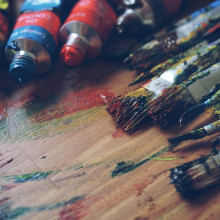
Finding forgeries
with Jeffrey Taylor, New York Art Forensics Institute
What happens when an old painting isn’t quite what it appears to be. As long as there has been art, there have been people willing to forge it. So how can science help weed out the Masterpieces from the Master Fakes? To find out, Adam Murphy spoke to Jeffrey Taylor, from the New York Art Forensics Institute...
Jeffrey - We begin looking at it with a lot of different types of light. So we're looking at it with normal light (visible light) and examining it very closely with microscopes, and then we move to the ultraviolet spectrum, and then we move to the infrared spectrum and we use that to see kind of through the painting and possibly to notice things like under drawing or other things underneath the paint layer.
Adam - So you could find something underneath that's absolutely not what you would expect from that artist.
Jeffrey - Yes you could. And of course, that's a common feature of a forgery; is that good forgeries will use - we have kind of a crude term for it: a donor painting, and that means a painting that they've picked up at a flea market and usually scraped down some of the paint, sometimes just painted right over it, but that will give them a good period canvas stretcher so all those parts of the painting will seem old and convincing. And so to look underneath and to perhaps see an earlier painting that would be entirely inconsistent - that'll be a clue right there!
Adam - And when you've done that, what would be the next step to move into?
Jeffrey - What we're looking at in general when we're doing an art forensics analysis, is we're particularly looking at the pigments and trying to come up with a date that this artwork could have been made. And we really are using a knowledge of the history of pigments to make that evaluation. And one of the driving forces in the evolution and development of new pigments is just moving away from toxicity. And that particularly is the case with whites, so lead white was the dominant white for painters really up until the 19th century and then they invented new ones in the 19th century that weren't so toxic based in barium and zinc but they weren't as good either. And then the really key invention is the development of titanium white, titanium dioxide, which we use a date of 1921 as its introduction. And that's really one of our most crucial dates is looking at whether an artwork contains titanium because that will very often help us solve a lot of cases. Latter day forgeries, things made in the 50s and 60s and 70s and more recently, but purporting to be from the early 20th century; we can often rule them out by the presence of titanium.
Adam - So let's say a Vermeer, then that wouldn't ever have titanium white in it so if it is there, you know it's a forgery.
Jeffrey - No it wouldn't. Yeah. I mean in Vermeer, the paintings of his period the 17th century, those are really simple. I mean, when we're looking at a potentially Rembrandt or potentially Van Dyck, it's a really small bunch of pigments that those artists had. It's amazing what great paintings they had. I mean, they're like working with like six or seven pigments and that's all they have. It just gets much harder as time goes by and you're looking at a painting that purports to be from a much more recent period.
Adam - How many forgeries do you get compared to genuine articles?
Jeffrey - It's sad. It's around, I would say 80 to 90 percent of what we study is not what the client was hoping it would be. And that can be many different variations, I mean, a forgery is where there's a clear intent to deceive. So usually that means a signature by a famous artist and the painting is not. And it was clearly produced with the intention of deceiving someone. We also just have fakes: things that weren't necessarily malicious, they've just been misattributed. And we have a lot of those cases. Or we might be looking at a 17th century painting and the client was really hoping it was by a very famous master, and it turns out that we determined it really is a 17th century painting but it's most likely by a lesser master working in the circle of that artist. So there's many different ways that an artwork can be less than authentic but yeah 80 to 90 percent of the time, it's kind of bad news.

45:40 - Inside the colour-making factory
Inside the colour-making factory
with Stuart Semple, Artist
What sorts of science go into creating all new pigments and what can they be used for. From the blackest black paint to the pinkest pink, Georgia Mills spoke to artist Stuart Semple, who has something of a magic factory when it comes to paint...
Stuart - I don't know where you start. It's a bit like Willy Wonka's Chocolate Factory in there. We've got paints that emit more light than any other paint. The pinkest pink that ever pinked to the blackest black you've ever painted with... things that change colour, things that compost, all sorts of stuff!
Georgia - I don't know where to start! How about you told me about your light emitting paint, your glowing paint…
Stuart - Yeah. We call it “Lit” and it's basically a similar sort of technology that you probably had on your bedroom ceiling as a kid where stars glowed. But ours is turned up to 12 on the dial, if you like. It goes for twelve hours, it's so bright, even in daylight it’s emitting light.
Georgia - Well I remember those stars, they were dim after half an hour…
Stuart - They were a bit rubbish, weren’t they.
Georgia - How have you managed this?
Stuart - Basically, we used different earth activators, so these are naturally occurring elements and metals, that absorb energy and then chuck it out again as light. But we found by combining different ones, they would emit different frequencies of light at different times. In essence, this mixture kind of self charges itself and so has a really bright initial glow and then an afterglow that just seems to go on almost indefinitely.
Georgia - And how did you go about finding these?
Stuart - Nowadays I actually have a forensic scientist in my studio, Jemima, who's absolutely awesome. She does a lot of research, a lot of development, a lot of sourcing and lot of playing. And we finally got a mix that played well together, where the different wavelengths of energy affected each other and made it work.
Georgia - I've got to say I haven't seen many glowing paintings. What kind of things does this one get used for?
Stuart - You wouldn't believe the things that people are using it for... One guy, the other day, mixed it in varnish and painted the whole floor of his house. We've had developing countries, interestingly, using it on road markings, and just artists making awesome sculptures and paintings… All sorts of stuff.
Georgia - Now to go to the other end of the spectrum, you mentioned you have the blackest black…
Stuart - Yeah we do.
Georgia - How?
Stuart - Where do you start? Let me start with the story of how and why I made the blackest black... About two years ago, a lab grew a forest of nanoparticles, these nanotubes, on surfaces and it trapped almost all light. It was absolutely amazing and the world was really excited - Ninety nine percent of light? Unbelievable. They did an exclusive deal with an artist called Anish Kapoor so only he could use it in his art and everyone was mortally offended and really annoyed.
I made the world's pinkest pink and I put it on my website and I said any artist can use the pinkest pink, as long as they're not Anish Kapoor. And I had to agree to a legal disclaimer that they weren't him or they weren't gonna share it with him. Anyway after I did that, everybody started writing into me and Anish actually got the pink and put it on his Instagram - a whole other story - and everyone's saying “you must make a black that’s better than his black!”. Here we are, two years later, we made Black 2 which was an awesome matte black.
But at that time, we had to use pigments that existed. And the problem with those is almost every black pigment, carbon’s the most popular one, reflects some kind of light. If you think for a lump of coal or charcoal, it reflects light, it's shiny. We wanted something that would absorb light. So we had to add additives to it that we borrowed from the cosmetics industry to mattify it, to dull it down to stop that light reflection from the front.
Unfortunately, when you have mattifiers to black paint, it adds whiteness so you start to get into tones of grey which is actually not what you want to. So since then we were working on black three and we finally finished it about a week ago after sending a thousand out to beta testers around the world. The way we approach now is we collaborated with a lab in Dallas who actually custom grew a pigment for us which is essentially a black pigment that's grown on a nano sized ceramic microsphere. So we have a matte black pigment which is amazing.
Georgia - Is this the better at absorbing light that it doesn't release as much as the other black?
Stuart - Absolutely, so it is not reflective it has like zero reflectance. The next thing we have to do is mix it into a paint which is the other side of this innovation. We've created an acrylic polymer to hold this stuff that has more bonds available than any other acrylic polymer which means we can supercharge it with pigments. What that means is in the visible light spectrum we're seeing between 98 and 99 percent of light absorption which, in English, means you get insanely weird looking black stuff. If you paint it on 3D things they look 2D like silhouettes. It's bizarre.
Georgia - Oh wow. What kinds of things do you think it could be used for and will you let that other artist use it?
Stuart - No, he can't have it unless he apologises and gives me my three pound ninety nine back for the pink. I have no idea what people are gonna use it for, so many people are asking, I know black is used in photography studios and some of the greatest artists around the world are using it but I don't know it's useful in telescopes. It's useful in paintings. I mean the blackest black… there’s so much you can make with it.
Georgia - Also, and just very very briefly, what's next?
Stuart - Next, we created a eucalyptus based, fully compostable, glitter which is absolutely awesome and we are looking to take that technology into acrylic paint so that we can make plant based, eco-friendly, robust acrylic paints.
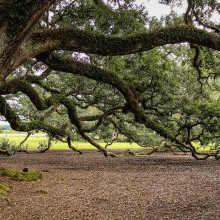
51:39 - Do plants eat dirt?
Do plants eat dirt?
Marcus was wondering how trees, such as giant oaks, can grow so huge and not make a hole in the ground. Where does their mass come from if not from the dirt? Jenny Gracie has been digging deep to find an answer, with help from Andrew Weatherall from the National School of Forestry at the University of Cumbria...
Andrew - Whilst it is rather wonderful to visualise plants having a tiny mouth at the end of each root, a kind of upside down Venus flytrap, the short answer is no, plants do not eat soil. As anyone with houseplants will have learnt, you do not have to go around topping pots up with soil as plants grow.
The proof that plants do not eat soil is attributed to a 17th century scientist called Jean Baptiste van Helmont. Van Helmont weighed a willow before planting it in a known weight of dried soil, five years later he re-weighed the tree, dried the soil and re-weighed that too. The willow had increased in mass, but the soil had not decreased. He might have thought that the soil had replenished in some mysterious way, but van Helmont actually concluded that the increase in weight ‘arose out of water only’.
Jenny - Evan_au on the forum also told this story about the willow experiment, and noted that the main mass of a tree is the water and cellulose content. Cellulose provides plant structure and is made up from long chains of carbon, oxygen and hydrogen. But did this really all come from just water?
Andrew - Despite his careful experimentation, this is unfortunately also the wrong answer. We now know that whilst plants derive water and nutrients from soil, their mass comes from air in the presence of sunlight. Einstein’s e = mc2 is the most famous formula in the world, but as a forester, my favourite is the net photosynthesis equation in which sunlight converts carbon dioxide and water into glucose and oxygen. Glucose is a sugar and this acts as a food source allowing trees like oaks to grow so huge, and the oxygen, well that keeps us going!
Jenny - On the forum, ChiralSPO agreed with this reasoning and wrote, “water and carbon dioxide from the air are the raw materials that account for most of the mass of a tree”.
So there’s our answer...photosynthesis: when plants need more food, they just have a light snack!
Next time we’re considering this question from Bree.
Bree - If a person is born completely deaf and can’t hear anything, what language do they think in?
Related Content
- Previous Why do we get butterflies?
- Next Do plants eat dirt?










Comments
Bree's question about deaf
Bree's question about deaf people thinking reminded me of something which I have always wondered about. As a sighted person, when I am asleep I can "see" things in my dreams, even though I am lying in a dark room with my eyes closed. What about a person who was born blind and has never seen anything? Do they have dreams with visual images? And what of someone who became blind in later life? Do they still "see" things when dreaming, even though they can't see any more with their eyes?
These links may help:
These links may help:
https://www.thenakedscientists.com/podcasts/ask-naked-scientists/do-blin...
https://www.thenakedscientists.com/articles/questions/how-do-blind-peopl...
Add a comment